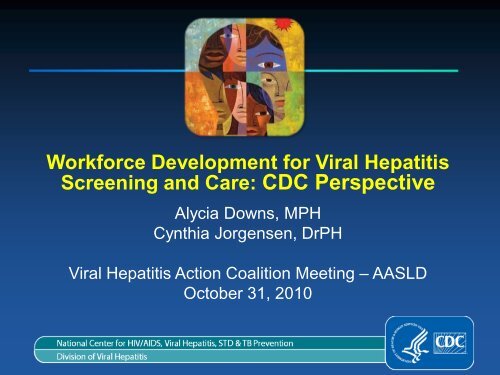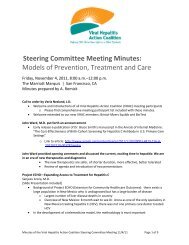Hepatitis: Blah Blah Blah - CDC Viral Hepatitis Action Coalition
Hepatitis: Blah Blah Blah - CDC Viral Hepatitis Action Coalition
Hepatitis: Blah Blah Blah - CDC Viral Hepatitis Action Coalition
Create successful ePaper yourself
Turn your PDF publications into a flip-book with our unique Google optimized e-Paper software.
Workforce Development for <strong>Viral</strong> <strong>Hepatitis</strong><br />
Screening and Care: <strong>CDC</strong> Perspective<br />
Alycia Downs, MPH<br />
Cynthia Jorgensen, DrPH<br />
<strong>Viral</strong> <strong>Hepatitis</strong> <strong>Action</strong> <strong>Coalition</strong> Meeting – AASLD<br />
October 31, 2010
Institute of Medicine’s Report<br />
Key Finding<br />
There is a lack of<br />
knowledge and<br />
awareness about chronic<br />
viral hepatitis on the part<br />
of the health care<br />
providers which impedes<br />
current efforts to prevent<br />
and control these<br />
diseases.
IOM Recommendation<br />
• Recommendation 3-1. The Centers for Disease<br />
Control and Prevention should work with key<br />
stakeholders to develop hepatitis B and<br />
hepatitis C educational programs for healthcare<br />
and social-service providers.
<strong>CDC</strong> Challenges<br />
• Resources<br />
• Mission of <strong>CDC</strong> vs. other federal agencies<br />
• Public health covers a broad spectrum of issues<br />
and audiences<br />
– Clinicians<br />
– Public health workforce<br />
– Consumers<br />
– Persons at risk<br />
• Traditional public health audiences vs. everyone<br />
– “low hanging” fruit vs. underserved and most at need
How can <strong>CDC</strong> implement this<br />
recommendation to increase<br />
knowledge and awareness of<br />
health care providers
What <strong>CDC</strong> Has Done and Can Do<br />
• Select <strong>CDC</strong> Examples – reaching health care<br />
providers<br />
– Immunization Education and Trainings<br />
– Clinician Outreach and Communication Activity<br />
– STD Training in Medical School Curriculum<br />
– NCHHSTP Training Overview<br />
• What Division of <strong>Viral</strong> <strong>Hepatitis</strong> is currently doing<br />
– Cooperative Agreements with Educational Institutions<br />
– State and local government<br />
– Professional Tools, Trainings & Resources<br />
– Other groups
<strong>CDC</strong> Examples
Immunization Education & Training<br />
• Immunization courses<br />
– Several formats: broadcasts, webcasts, DVD, CD ROM<br />
and web-based<br />
• Epidemiology & Prevention of Vaccine-<br />
Preventable Diseases Course<br />
– Principles of vaccination, recommendations, immunization<br />
strategies, vaccine-preventable diseases and vaccines<br />
• NetConferences: Current Issues in Immunization<br />
– Live, 1-hour presentations with question and answer session<br />
• On-Site Training<br />
– Live course by <strong>CDC</strong> trainers, available for a state or region.<br />
• Podcasts<br />
– Download to desktop and portable music/video player
Clinician Outreach and<br />
Communication Activity (COCA)<br />
• <strong>CDC</strong>’s Emergency Communication System<br />
• Partner with over 180 clinician organizations<br />
• Connect directly with clinicians<br />
• Work collaboratively in times of emergency &<br />
preparedness<br />
• Provide tools, training and consultation<br />
• Evaluation data show direct impact on clinical<br />
practice
Medical School Curriculum<br />
• National Center for HIV, <strong>Viral</strong> <strong>Hepatitis</strong>, STDs and<br />
TB Prevention (NCHHSTP) worked to integrate<br />
comprehensive STD training into medical school<br />
curriculum<br />
• IOM report advocates for development of improved<br />
curricula to ensure graduates are knowledgeable<br />
about chronic viral hepatitis<br />
– Prevalence, risk factors, preventive actions, appropriate<br />
diagnostics, screening recommendations, appropriate<br />
follow-up for chronically infected and those susceptible to<br />
infection
NCHHSTP Training Overview<br />
• Division of HIV/AIDS Prevention & Division of STD<br />
Prevention jointly fund the Prevention Training<br />
Centers<br />
– Part I: STD Clinical Training - 10 regional sites<br />
– Part II: Behavioral Interventions – 4 regional sites<br />
– Part III: Partner Services & Program Support Training –<br />
4 regional sites<br />
• Division of Tuberculosis Elimination funds the TB<br />
Regional Training and Medical Consultation<br />
Centers<br />
– 4 regional sites
The Federal Training<br />
Centers Collaboration (FTCC)<br />
• The purpose of the FTCC is to increase<br />
collaboration among DHHS funded training<br />
centers involved in educating health care<br />
workers about HIV/AIDS and other comorbidities<br />
that affect similar populations<br />
• Primary focus on HIV/AIDS due to funding<br />
• There are no viral hepatitis “training centers”<br />
– Represent two training cooperative agreements
Division of <strong>Viral</strong> <strong>Hepatitis</strong><br />
Examples
HepWebStudy.org<br />
• University of Washington<br />
– Purpose: To educate clinicians on prevention,<br />
management and treatment of hepatitis A,B, and C<br />
– Format: interactive, clinically-relevant case studies.<br />
– Free CME and CNE credits available<br />
– Audience: Physicians, other clinicians<br />
– Web-based trainings to reach the maximum numbers<br />
– Funded at $150,000/year
Know<strong>Hepatitis</strong>.org<br />
• University of Alabama, Birmingham<br />
– Purpose: To enhance knowledge and skills by providing<br />
practice-focused opportunities on viral hepatitis<br />
prevention and control<br />
– Format: distance learning<br />
– Target Audience: Frontline workers in community based<br />
organizations and clinics–those in direct contact with<br />
people who are at risk for viral hepatitis<br />
– Actual Audience: Frontline workers and health care<br />
providers (physicians and nurses)<br />
– Funded at $150,000/year
Adult <strong>Viral</strong> <strong>Hepatitis</strong> Prevention<br />
Coordinators<br />
• One <strong>CDC</strong> funded position per state/territory and<br />
select cities<br />
• Coordinators provide the technical expertise for<br />
activities directed toward prevention of viral<br />
hepatitis infections and integration of prevention<br />
services into health care settings and public health<br />
programs
<strong>CDC</strong> – Web Based Resources<br />
• <strong>Viral</strong> <strong>Hepatitis</strong> Serology Training<br />
– Target Audience: Physicians, Registered Nurses, Public<br />
Health Professionals<br />
– Objectives:<br />
• Understand the different serologic tests for hepatitis<br />
• Understand the serological diagnosis of hepatitis,<br />
acute and chronic<br />
• Understand the meanings of serologic markers and<br />
interpret serologic test results<br />
• Professional Tools and Cheat Sheets<br />
– Professional Resource Center
www.cdc.gov/hepatitis
Medscape<br />
• <strong>CDC</strong> Expert Commentary Series<br />
– Dr. Ward - Screening Asian Patients for Chronic<br />
<strong>Hepatitis</strong> B<br />
• CME activity based on <strong>CDC</strong>’s chronic hepatitis B<br />
testing guidelines
Next Steps:<br />
A National Education Campaign
Our Vision for a National Campaign<br />
Goal: Decrease the disease burden of<br />
viral hepatitis<br />
• Raise awareness<br />
• Engage opinion leaders, policy makers,<br />
media, & the public<br />
• Change perceptions & decrease stigma<br />
• Educate providers & build capacity<br />
• Encourage testing<br />
• Save lives with early intervention
Campaign Strategies<br />
• Implemented in 3 overlapping phases<br />
• Multi-media strategies tailored for each phase<br />
• Provider education strategically planned prior<br />
to the direct-to-consumer component<br />
• Separate public campaigns for hepatitis B<br />
and hepatitis C<br />
• Supplemented by education and community<br />
mobilization grants<br />
• Pilot tested in 3 different cities
Campaign Phases<br />
Phase I Opinion Leaders, Policy Makers, Media,<br />
Healthcare Providers, General Public<br />
Raise<br />
Awareness<br />
Support<br />
<strong>Action</strong><br />
Phase II<br />
Educate<br />
About<br />
<strong>Hepatitis</strong> &<br />
Guidelines<br />
Build<br />
Capacity to<br />
Screen,<br />
Refer, Treat<br />
Healthcare Providers<br />
Phase III Populations at Risk<br />
Encourage Testing
Community<br />
Mobilization<br />
Spheres of Influence<br />
General Public<br />
Opinion<br />
Leaders<br />
&<br />
Policy<br />
Makers<br />
Healthcare Providers<br />
Populations at Risk<br />
B C
Proposed Communication Channels<br />
Opinion<br />
Leader<br />
Outreach<br />
News/Media<br />
Advocacy<br />
Digital &<br />
Social Media<br />
Professional<br />
Education<br />
National<br />
Education<br />
Campaign<br />
Public Service<br />
Advertising<br />
(earned &<br />
paid if<br />
possible)<br />
Community<br />
Mobilization<br />
& Outreach<br />
Special<br />
Events<br />
Public-<br />
Private<br />
Partnerships<br />
Collateral<br />
Materials
Potential Campaign Messages<br />
• Millions of Americans are living with hepatitis –<br />
many don’t know it<br />
• <strong>Hepatitis</strong> is a leading cause of liver cancer<br />
• Early intervention can save lives<br />
• 1 in 12 Asian Americans has<br />
hepatitis B<br />
• Protect your loved ones<br />
• New treatments are helping<br />
people live longer, healthier lives<br />
Phase I<br />
Provider Education and Capacity Building<br />
Phase II<br />
Educate about <strong>Viral</strong> <strong>Hepatitis</strong> &<br />
Existing & Upcoming Recommendations<br />
Phase III<br />
•1 in 30 Baby Boomers has hepatitis C<br />
• 3 of every 4 people with this disease<br />
may not know they are infected<br />
• If you are at risk, get tested<br />
•Treatment can eliminate the virus
Campaign Planning Process<br />
• News media outreach - ongoing<br />
• Formative or Market Research<br />
– Providers<br />
– Public<br />
• Strategies and Material Development<br />
– Developed and vetted<br />
– Tested in controlled settings<br />
– Implemented in pilot cities<br />
• Roll out of National Campaign
Findings from the Literature<br />
Provider Knowledge and Attitudes<br />
• Inadequate knowledge<br />
– Risk factors ─ Screening/Testing<br />
– Disease progression ─ Treatment<br />
• Stigma associated with disease<br />
• Perceptions about treatment efficacy are not<br />
current<br />
Provider Practices<br />
• Risk assessment often not done<br />
• Screening often not performed
Findings – con’t<br />
Clinical Features<br />
• Infection goes unnoticed until symptoms of<br />
advanced liver disease develop<br />
Patient Factors<br />
• Patients avoid disclosing risk behaviors due to<br />
stigmatization<br />
System Issues<br />
• Lack of coverage or reimbursement may hinder<br />
screening<br />
• Screening guidelines inconsistent
Resulting in…<br />
• Lack of screening<br />
• Confusion over guidelines<br />
• Patients failing to receive:<br />
– Risk assessment<br />
– Screening<br />
– Vaccination<br />
– Clinical testing<br />
– Treatment
<strong>CDC</strong>’s Response<br />
• Issuance of guidelines/recommendations<br />
• Formative research<br />
• Intervention research and evaluation<br />
• Technical assistance<br />
• Support/funding for medical education<br />
• Development and dissemination of trainings<br />
• Fostering collaborations and partnerships
Proposed Research Questions<br />
Primary Care Providers<br />
• Do they screen for viral hepatitis Why or why not<br />
• What influences their screening behavior<br />
– Knowledge levels<br />
– Patient preference<br />
– System or organizational influences<br />
• Are they aware of <strong>CDC</strong>’s guidelines<br />
– Chronic <strong>Hepatitis</strong> B vs. <strong>Hepatitis</strong> C<br />
• What can we learn from awareness of <strong>CDC</strong>’s<br />
chronic B guidelines to help in planning for new<br />
hepatitis C guidelines<br />
• Which organizations/guidelines have the most<br />
influence and credibility
Thank you<br />
For more information, please contact the Centers for Disease Control and Prevention<br />
Division of <strong>Viral</strong> <strong>Hepatitis</strong><br />
1600 Clifton Rd, Mail Stop G-37<br />
Atlanta, Georgia 30333<br />
404-718-8596<br />
www.cdc.gov\hepatitis



